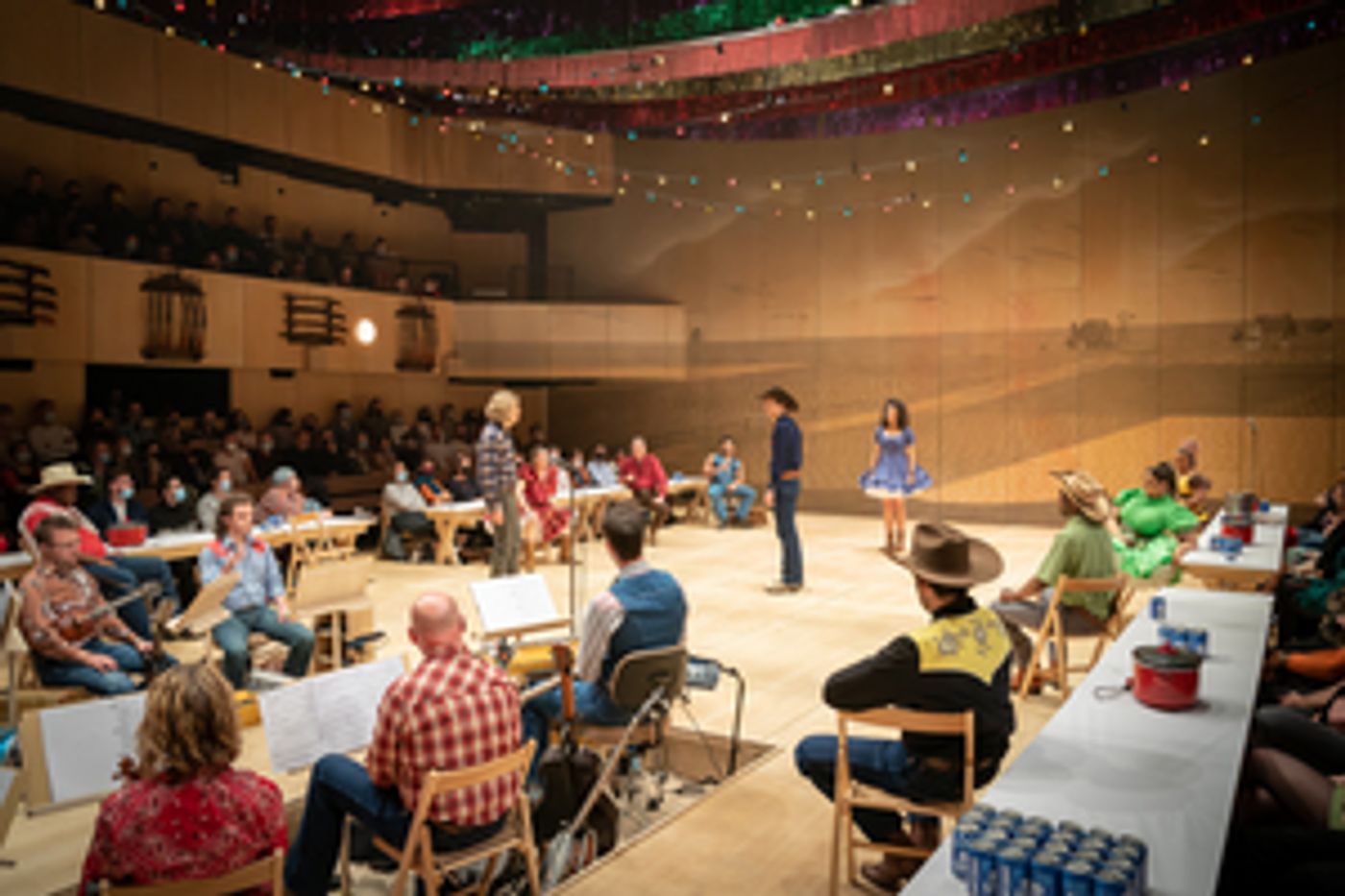Review: OKLAHOMA!, Young Vic
Daniel Fish and Jordan Fein's Tony-winning revival comes to London.

![]() Forget the butter-churner and the lasso. This Oklahoma! has no need of them. Following a Broadway run and a U.S. tour, Daniel Fish and Jordan Fein's Tony-winning production of the Rodgers and Hammerstein musical comes to London's Young Vic like a hipster cowboy riding into town. In their audacious interpretation, the heart and soul of this American classic offer themselves up in a new, disturbing guise. For what comes into view by the end of its three hours is a vision of American communality forged not only in camaraderie, but also in conflict and blood.
Forget the butter-churner and the lasso. This Oklahoma! has no need of them. Following a Broadway run and a U.S. tour, Daniel Fish and Jordan Fein's Tony-winning production of the Rodgers and Hammerstein musical comes to London's Young Vic like a hipster cowboy riding into town. In their audacious interpretation, the heart and soul of this American classic offer themselves up in a new, disturbing guise. For what comes into view by the end of its three hours is a vision of American communality forged not only in camaraderie, but also in conflict and blood.
From the start, Oklahoma! welcomes its audience into the fold of that community. Laura Jellinek and Grace Laubacher's stripped-back design positions us within a wooden-panelled, brightly-lit setting decked with rectangular tables and resembling a town hall. Dozens of rifles, colourful streamers, and a wall-sized drawing of a Midwestern farm inject this environment with a more concrete sense of rural life. A third of this in-the-round space is occupied by the onstage band, led by Tom Brady, and some members of the audience sit at the tables. When the cast confidently walk into this arena and take their seats, we feel as if a casual ceremony is about to commence.
Two love triangles dominate the plot of Oklahoma!: The primary one concerns farm girl Laurey (Anoushka Lucas), whose teasingly stand-offish flirtations with cowboy Curly (Arthur Darvill) see their stakes raised when the farmhand Jud (Patrick Vaill) reveals his interest in her. The increasingly dark conflict between Curly and Jud is counterpoised by the playful rivalry between cowboy Will (James Davis) and peddler Ali Hakim (Stavros Demetraki), who each has a romantic liaison with Laurey's friend Ado Annie (Marisha Wallace). As these young lovers find their relationships strained around an imminent box-social dance, their wider community faces a test of loyalties.
Fish and Fein's staging lets these twinned dramas unfold with a kind of fated fluidity that has at times a mechanical feel to it. Especially in the first half, members of the ensemble tend to stay on stage as spectators of scenes where they don't appear, constituting a public eye or an unresponsive chorus. But intimacy still finds its way: moments of romantic intensity are elegantly accentuated by big changes to Scott Zielinski's ever-surprising lighting design, whereby the whole auditorium gets bathed in green or sepia.
Joshua Thorson's large-scale live projections, too, boldly bolster two episodes of haunting interiority: the first, during "Pore Jud is Daid," follows a complete blackout where Curly tries to intimidate Jud, and the second marks Laurey's dream ballet, which becomes here a solo interpretive dance featuring Marie-Astrid Mence and accompanied by fog and a phantasmagoric soundscape (sound design by Drew Levy).
John Heginbotham's unassumingly brawny choreography encourages the cast to navigate the playing space in realistic and dynamic ways. Whether stamping their feet, slapping their thighs, or hitting on tables, the performers strikingly embody a community emboldened by their expressive gestures. They crush Bud Light cans and shuck corns with assertive zest. At once down-to-earth and hearty in their movements, they persuasively claim the space as their own, especially as they fiercely perform the titular song.
A range of impressive performances is vital to the production's stylish gutsiness. Lucas and Darvill are at their soulful best when they amplify and play around the charged affection between their characters, as in their layered take on "People Will Say We're in Love." Vaill brings conspicuous nuance into his portrayal of the outsider Jud, turning him into a vulnerable character ultimately crippled by his unrequited love.
Another highlight of the evening is Wallace's Ado Annie, who seductively straddles confidence and ingenuousness in her juggling of two men. Her "I Cain't Say No" is a showstopper. With their tightly controlled, suave performances, Demetraki and Davis are a worthy match for her. Liza Sadovy's sympathetically firm Aunt Eller provides a neat contrast to their youthful frolics.
The combination of these assured performances makes for a production that feels distinctly contemporary in its sensibility. So much so that, at times, the freshly lyrical mood cultivated on stage seems to hamper the overall momentum, with some scenes overstretching themselves. In terms of choreography, too, some of the busier episodes struggle to highlight their compositional centres and feel somewhat frayed. Leaving the audience well-lit most of the time, Oklahoma! makes it unduly easy for our eyes to wander around and doesn't always encourage the sort of attentional immersion it seems to aspire for.
Notwithstanding these occasional issues, Fish and Fein's revival is hugely admirable for the new angles from which it approaches its material, while remaining loyal to its text. Perhaps it is even an object lesson in how to stage classic works whose underlying assumptions - especially the more troubling ones - merit thoughtful investigation and imaginative interpretation. By the end of Oklahoma!, we have both seen an iconic show in its entirety and witnessed a critical response to it - two birds with one stone. That's a rare achievement, and a most welcome one.
Oklahoma! at the Young Vic until 25 June
Photo credit: Marc Brenner
Reader Reviews
Videos

